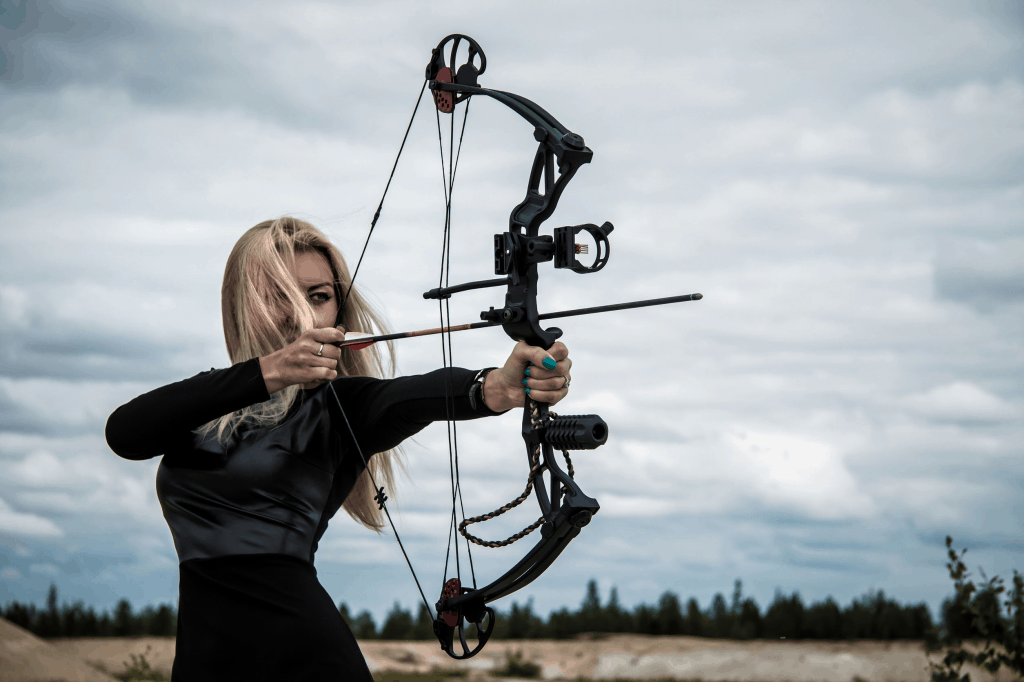
As with any projectile, the speed of an arrow is essential to its function. You can’t take part in effective target practice if your arrow isn’t going fast enough to even pierce the target. As bows have evolved, the maximum speed of an arrow has greatly increased.
The speed of an arrow shot from a compound bow varies depending mainly on the type of compound bow, its draw length, draw weight, and the weight of the arrow. Most contemporary compound bows shoot at a speed between 300 and 340 feet per second.
There are many factors that go into making a bow fast. This article will go in depth about some of those factors so you can understand why compounds can shoot arrows faster than any other bow.
Calculating the Speed of Arrows
First, let’s make sure we understand how bow technicians and archery fanatics determine the speed of an arrow.
An arrow’s speed is measured in feet per second. Many compound bows will come with an advertised rate of speed, but that’s not the speed the arrow is travelling at when it hits the target.
The advertised speed of a compound bow is the speed at which the arrow is travelling at directly after it is released from the bow’s string.
In other words, the speed of your bow is its speed at point-blank range. By the time the arrow reaches its target, it will probably be going much slower than the 340 fps your bow was advertised at.
That speed is also tested under certain conditions that may be different from those you’re shooting in.
Most, if not all, compound bow manufacturers adhere to the International Bowhunting Organization (IBO) standard of bow testing.
In order to ensure that the speed ratings of bows from different companies are consistent, IBO testing mandates that bows be tested using:
- 70 lbs of draw weight
- 30″ draw length
- 350-grain arrows
This means that the speedy new compound bow you just bought may not actually be shooting its arrows at 345 fps like you thought.
If you opted for the version of the bow that is only 50 lbs of draw weight, you’re certainly not shooting at the advertised fps.
If you have a slightly shorter draw length or arrows heavier than 350 grain, you’re likely to have a slower speed.
Weather conditions must also be taken into consideration.
The majority of bows were probably tested in an indoor environment where the conditions are tightly controlled.
Bowhunters dealing with anything other than a perfectly clear, windless day are going to experience more resistance and interference than the technicians in the lab.
Most compound bows do not comply with the exact specifications of the IBO tests, and many people don’t use 350-grain arrows, so just keep in mind how rare it is to shoot at the speeds that manufacturing companies advertise for their bows.
How Certain Factors Affect Arrow Speed

As mentioned, arrow speed is the result of a conglomeration of mechanical processes occuring at various points on a compound bow.
The best way to be able to calculate or evaluate speed for yourself is to have a clear understanding of these components.
Draw Length
Draw length, or the distance you can pull a string from its resting position to full draw, is an important factor in propelling your arrow.
The IBO test is usually performed with a draw length of exactly 30 inches, but that measurement is not unanimous among compound bow models.
It’s estimated that shortening this length by even one inch can cost you 10 fps in your shots.
Draw Weight
IBO-certified compound bows were all tested at a draw weight of 70 pounds.
But not all bowhunters need a 70-pound draw weight to take down their game of choice.
70 pound draw weights are typically only used to take down the biggest game, including bears, moose, and some large elk.
For those shooting white-tailed deer or smaller game, and especially for those just looking to do some target shooting, you may only need 50 or 60 pounds of draw weight.
But lower draw weights mean lower rates of speed.
Seasoned archers have purported that a bow looses 15 to 20 fps for every ten pounds of draw weight deducted from the benchmark 70.
So, if you bought the version of your bow that has a 50-pound draw weight, you could be shooting at 40 fps less than the 70-pound version.
Arrow Weight
Arrows come in a wide variety of materials nowadays, and every material has a different weight.
The 350-grain arrows that IBO bow testers use are incredibly light, especially for bowhunting.
Most avid bowhunters need an arrow with a heavier grain to take down their target, something with closer to 425 grain.
Though grains are relatively small units of measurement, they do have an impact of the speed of an arrow in flight.
For every added 5 grain of arrow weight, archers can expect to lose around 1.5 fps.
It may not seem like much, but with such a great difference between the IBO testing arrow and the real thing, total losses are likely to be more than 20 fps.
String Accessories
No, this isn’t referring to lengths of string being tied around the arrow to make its flight more fun to watch.
Dedicated bowhunters often make additions to their string in order to help them aim or release.
Even small, light accessories like a D-loop and peep sight are going to add to the weight of your compound bow’s string, and the heavier your string is, the more fps you lose in the shot.
Method of Release
Nearly everything about the IBO test is automated, right down to the release method used to let go of the string and send the arrow flying.
To eliminate human interference, bow technicians use a machine to release the string to get the most accurate readings on the speed of the arrow.
But the problem is that the bows are being shot by people in real life.
People, no matter how experienced, you cannot be as efficient or consistent at releasing the string as a machine can, so there’s likely to be a few fps knocked off the speed every time you shoot merely because you’re a human.
Every bow company wants to be the first to say they’ve broken the speed barrier. They also want to sell more bows.
It’s best to take every advertised IBO speed with a grain of salt and remember that it’s nearly impossible to match their pristine standards of shooting.
Fastest Compound Gear on the Market

That being said, let’s take a look at some of the market’s fastest compound bows and arrows.
Bear Archery’s 2019 Escape model has been rated amongst the fastest bows on the market with an impressive 350 fps.
This bow’s draw length can be adjusted to the IBO level of 30 inches, but it can also go as low as 25.5 inches, so remember that you won’t get that 350 fps if you truncate the draw length.
Coming in a close second is the Bowtech Prodigy, which claims to shoot arrows at 343 fps.
This bow is also adjustable, though Bowtech decided to provide more variety in the draw weight rather than the draw length.
The Prodigy can be adjusted to anywhere between 50 and 80 pounds.
Of course, this means you could lose fps on the speed if you reduce the weight to less than 70 pounds, but you may actually gain speed by bringing the weight up to 80 pounds.
This might be a more doable option than many would think, as the Prodigy has an 80% let-off at the end of the draw, lifting the burden of that 80 pounds significantly.

As for arrows, it can be difficult to find some at 350 grain, but if you’re in the market for some IBO-approved arrows, this six-pack of Game Slayer Carbon Arrows can be found on Amazon for just $39.41.
You can still have a fast shooting experience without complying with each an every IBO standard, and just because the rated fps of a particular bow may not be exactly true in all circumstances, you can still shoot an arrow faster than most cars will ever drive.
If you have the need for speed, there are a lot of compound bows on the market to satisfy your need.
